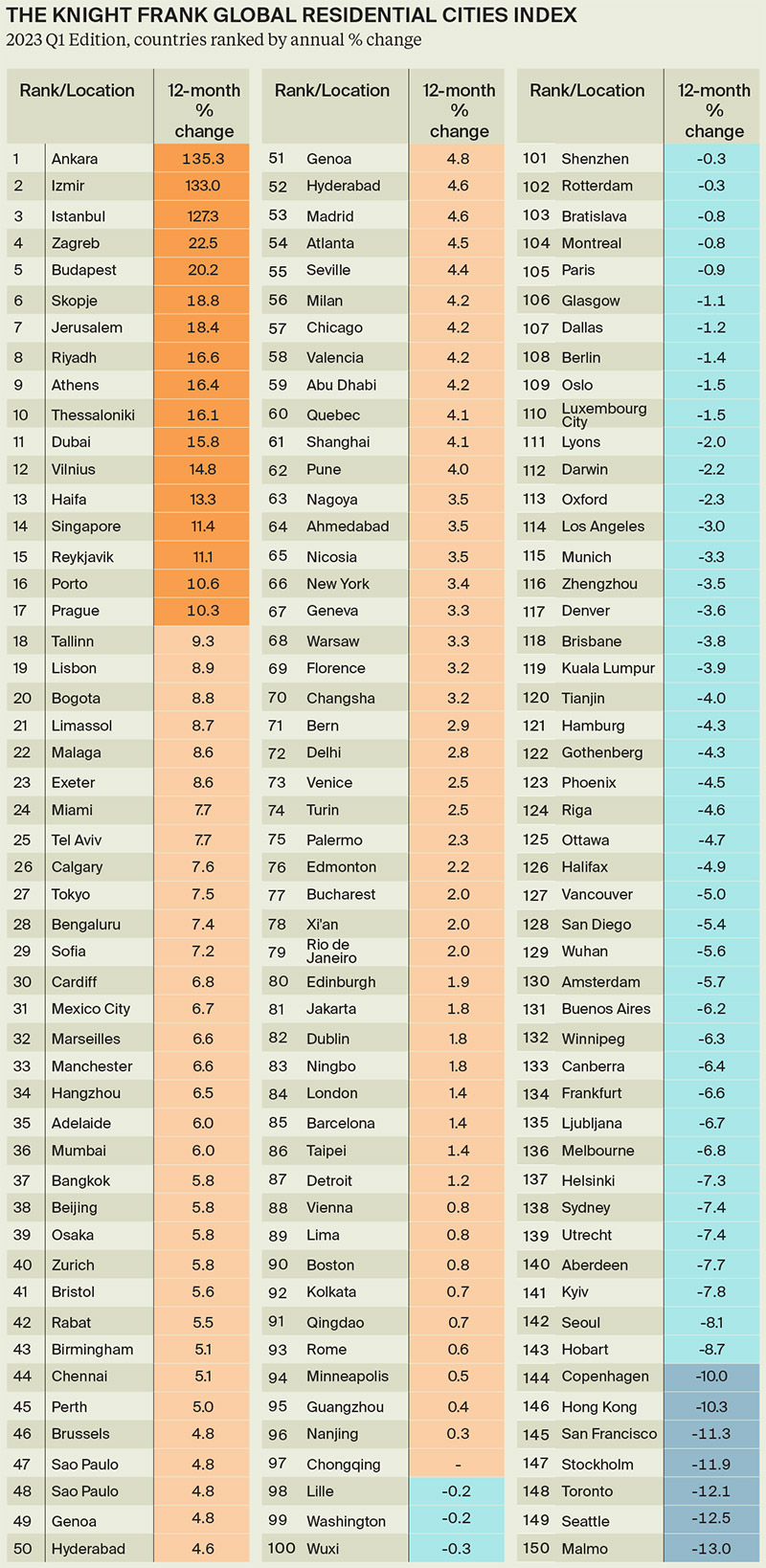In property market World Cup, Sydney and Melbourne in relegation zone
When it comes to property market performance globally, Australia’s state capitals are nowhere to be seen among the better performing cities in the world.
If there was a property market World Cup, no Australian city would have qualified for the 2023 event.
When it comes to property market performance globally, Australia’s state capitals are nowhere to be found among the top 32 cities in the world, the number of representatives that would typically play in a sporting world cup tournament.
Adelaide’s annual residential dwelling increase of 6.0 per cent ranked it 35th among the 150 cities assessed as part of the Knight Frank Global Residential Cities Index (2023 Q1) released this week.
Sydney, Melbourne and Hobart, meanwhile, would be staring at relegation to the lowest league on offer.
The lacklustre performance of Australian cities was mirrored by the overall performance of international property markets.
Average annual growth across the 150 cities included in the Knight Frank Global Residential Cities Index averaged 3.1 per cent in Q1 2023, down from the 6.6 per cent recorded in the previous quarter, and well below the recent peak of 11.6 per cent, achieved in Q1 2022.
Unique inflationary conditions in Türkiye resulted in three of that country’s cities recording triple-digit growth over the year, while European cities Zagreb, Budapest and Skopje each delivered property price growth above 20 per cent.
Among Australian cities, Perth followed Adelaide in 45th place with its 5 per cent growth. From there it was all negative territory and rankings in the hundreds. Darwin placed 112th (-2.2 per cent), Brisbane came in at 118 (-3.8 per cent), Canberra 133rd (-6.4 per cent), just ahead of Melbourne (136; -6.8 per cent) and Sydney (138; -7.4 per cent). Hobart bettered just seven cities on the list as it ranked 143rd with prices falling 8.7 per cent.
Article continues after list

Source: Knight Frank Research, Macrobond.
A tough year for property globally
Annualised price growth across the Knight Frank Global Residential Cities Index has fallen sharply in recent quarters, from a high of nearly 12 per cent at the beginning of 2022, when cities around the globe were experiencing a bounce in demand for accommodation following pandemic lockdowns.
The Knight Frank report found that among all 150 cities prices rose on average by 3.1 per cent in the 12 months to March 2023 but with the slowdown in price growth accelerating.
More than half (51 per cent) of the cities in the index saw prices fall over the most recent three-month period, with seven markets seeing prices fall by more than 5 per cent.
According to Statista, the global inflation rate in 2022 was 8.7 per cent and so far in 2023 has averaged 7.0 per cent, far outstripping the broad measure of global property price growth.
The Knight Frank report said the key issue for all markets remains the outlook for inflation, interest rates and economic activity.
“The Federal Reserve in the US seems to be closing in on peak rates in the current cycle, as inflation across the US slows rapidly,” the report noted.
“Other central banks will likely follow through 2023, with falls in Eurozone and UK inflation lagging the US by between three and six months.”
Liam Bailey, Knight Frank’s Global Head of Research, said the slowdown in housing markets is unsurprising given the shock of higher interest rates in developed economies.
“Our latest results confirm that more than half of key global city markets saw prices fall in the most recent three-month period,” he said.
2024 may bring brighter real estate news
Looking ahead, the remainder of 2023 is seen to be sluggish at best, with more upside to world property markets expected to evolve in 2024.
“We need to expect further price falls through 2023 as markets adjust to higher debt costs, however, the downward shift in inflation in the US and other economies points to improving economic conditions,” Mr Bailey said.
“Economic fundamentals - wage growth and economic expansion - should permit a return to growth for most markets from 2024.”
The global economy will expand 3 per cent this year, down from 3.5 per cent last year, the International Monetary Fund (IMF) said in its latest World Economic Outlook on 24 July.
That’s a 0.2 per cent upgrade from its April projection. The IMF noted that global economic activity in the first quarter of the year proved resilient. Energy and food prices have come down sharply from their war-induced peaks, allowing global inflation pressures to ease faster than expected.
The IMF, which earlier this year labelled Australia’s property market the second riskiest in the world, has said balance of risks remain tilted to the downside.
“Interest rates are now in contractionary territory, weighing on activity, slowing the growth of credit to the non-financial sector, increasing households’ and firms’ interest payments, and putting pressure on real estate markets,” it reported in its Outlook.
“Core inflation, meanwhile, remains well above target and is declining only gradually. Nevertheless, stronger growth and lower inflation than expected are welcome news, suggesting the global economy is headed in the right direction,” the IMF concluded.





















